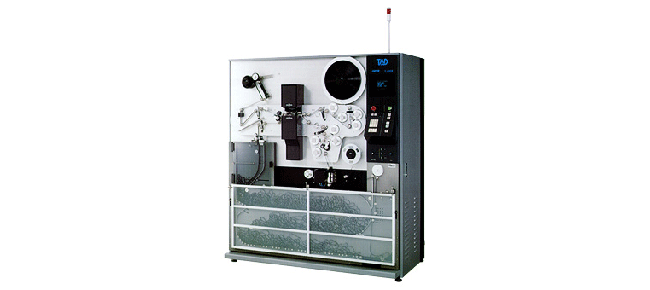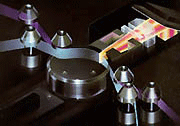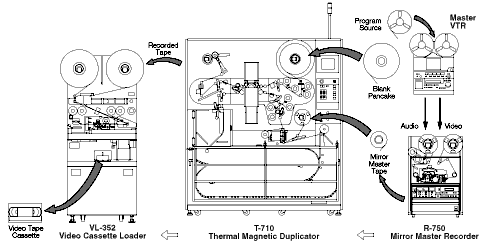| This product has been discontinued. |
|
Features
|
 |
The Otari T-710 high speed video duplicating system produces commercial quality copies of VHS SP and EP mode video recordings in NTSC and in SP mode for the PAL/SECAM standard, using a proprietary high speed contact-printing process. Copies are produced on pancakes of chromium dioxide video tape at a speed of 10 meters (394 inches) per second. The effective duplication ratio is 300 times real-time for NTSC VHS SP mode, 900 times real-time for VHS EP mode, and 428 times real-time for PAL/SECAM standard VHS tapes.
The T-710 is based upon a high speed duplicating concept that utilizes the unique thermo-remanent characteristics of chromium dioxide particles. This technology, called Thermal Magnetic Duplication, or TMD, uses blank 1/2" magnetic tape containing chromium dioxide which is rapidly heated to above its Curie temperature and allowed to cool while in intimate contact, coating to coating, with a high Curie point master tape containing a mirror-image recording of the desired program. The copy tape's magnetic particles, after cooling below their Curie point, retain a permanent mirror image copy of the magnetic pattern of the master tape. Because the information contained on the tape does not have to be processed electronically, extremely high tape speeds and thus very large duplication ratios can be achieved.
TMD - Thermal Magnetic Duplication - High Speed Video Duplication System
With wide-spread home VHS cassette decks, video releases are still mainly via tape media. To release the latest programs in quantity, high speed duplication of video tape is indispensable. However, because of wideband (30 Hz to 4.5 MHz) of video signal and complexity of herical scan system, high speed video duplication is technically not straightforward. On the other hand, the conventional real time copy system requires hundreds or thousands of video decks, space to install them, and many operators, etc. It is not an economical solution.
Otari has developed a compact and highly productive video tape duplication system, the Thermal Magnetic Duplication (TMD) system. Currently over 200 units of the TMD system have been shipped all over the world. Because the information contained on the master tape does not have to be processed electronically (playback and record) on the TMD system, extremely high tape speeds and thus very high copy ratios can be achieved.
Thermal Magnetic Duplication Theory

The physicist Pierre Curie determined that if a magnetic material is heated beyond a certain temperature (called the Curie temperature or Curie point), the ferromagnetic domains inherent in the material will become randomly oriented or paramagnetic.
Above the Curie point, the spins of individual particles become randomized because of thermal agitation. This paramagnetic condition allows the magnetic spins of the particles to align themselves in proportion to the strength of an external magnetic field. As the temperature is brought back below the Curie point, the paramagnetic ordering is locked in and remains permanent. In other words, if a magnetic material is heated beyond its Curie point and then exposed to an external magnetic field as it cools, the heated material will retain the orientation of the external magnetic field.
The phenomenon of magnetic transference at the Curie point can be used to duplicate video tapes by heating blank chromium dioxide tape to its Curie point while bringing it into close proximity to a magnetic mirror image of the tape which is to be duplicated, and then keeping the two tapes in contact as they are allowed to cool.
Different magnetic pigments have different Curie points. For example, the Curie points of chromium dioxide (CrO2) tape formulations, at 130°C, are significantly below the Curie points of cobalt-iron (CoFe) formulations which have Curie points on the order of 500°C. This means that a relatively low temperature source of heat can be used to raise the tape beyond the Curie temperature.
Although just slightly above the critical temperature for maintaining polyester base stability, the Curie temperature of a CrO2 based tape is sufficiently low that rapid heating and cooling can essentially eliminate overheating of the base film and mechanically deforming the tape.
Production System Overview
The TMD video tape production can be divided into the three steps:
1. Mirror master tape production: Video signals played back with an 1" master VTR machine are recorded by a mirror master recorder (MMR. Otari R-750) as a mirror image of an original master tape on 1/2" metal-particle master tape.
2. Tape duplication: The mirror master tape is threaded on the high speed duplicator (Otari T-700, T-700II, T-700III or T-710) and made in an endless loop. The master and slave tapes are brought into contact using high pressure air at the print wheel, a precision air bearing with a mirror finished surface and an air cap, where the slave tape is rapidly heated by the laser light up to more than 130 deg C, and then immediately allowing the tape to cool while still in contact with the master to transfer the mirror image of the master tape to the slave tape. The latest T-710 can copy a 2-hour long movie program in about 24 seconds (NTSC-SP mode).
3. Tape loading: The printed slave tape is loaded into empty cassettes (V-0) by using 1/2" video tape loaders (Otari T-320II, VL-352). Loading is done automatically by detecting cue signals recorded at the beginning of the program. A T-120 cassette can be completed in about 20 seconds (with VL-352).

|
|
 home
home home
home